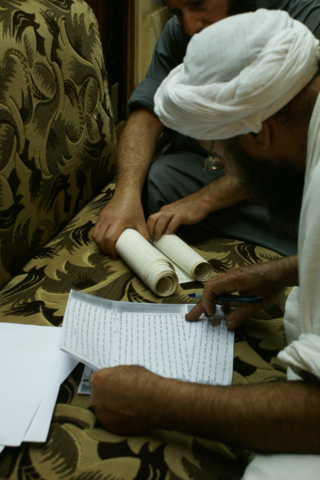
The Qulasta, also spelled Qolastā in older sources, is a compilation of Mandaean prayers. The Mandaic word qolastā means "collection".
Ethel, Lady Drower was a British cultural anthropologist, orientalist and novelist who studied the Middle East and its cultures. She was and is still considered one of the primary specialists on the Mandaeans, and was the dedicated collector of Mandaean manuscripts.

A rasta is a white ceremonial garment that Mandaeans wear during most baptismal rites, religious ceremonies, and during periods of uncleanliness. It signifies the purity of the World of Light. The rasta is worn equally by the laypersons and the priests. If a Mandaean dies in clothes other than a rasta, it is believed that they will not reenter the World of Light, unless the rite "Ahaba ḏ-Mania" can be performed "for those who have died not wearing the ritual garment."
In Mandaeism, Hayyi Rabbi, 'The Great Living God', is the supreme God from which all things emanate.
The Wedding of the Great Shishlam is a Mandaean text. As a liturgical rather than esoteric text, it contains instructions and hymns for the Mandaean marriage ceremony. Traditionally, Mandaean priests recite the entire book at marriage ceremonies. The hymns in the text often contain the refrain "When the proven, the Pure One Went." Unlike most other Mandaean ritual scrolls, The Wedding of the Great Šišlam is not illustrated.

The Coronation of the Great Šišlam is a Mandaean religious text. The text is a detailed commentary on the initiation of the tarmida, with detailed discussions on masbuta and masiqta rituals. The Scroll of Exalted Kingship is also used extensively alongside the Coronation in tarmida initiation rituals. Similar esoteric texts that are traditionally used exclusively by Mandaean priests include The Thousand and Twelve Questions, and The Baptism of Hibil Ziwa.

A tarmida is a junior priest in Mandaeism. Ganzibras, or head priests, rank above tarmidas.
A ganzibra is a high priest in Mandaeism. Tarmidas, or junior priests, rank below the ganzibras.
Alma Rišaia Zuṭa is a Mandaean religious text. The text is used for Mandaean priestly initiation ceremonies. It is written as a scroll. Alma Rišaia Zuṭa complements Alma Rišaia Rba, or "The Greater Supreme World", a related Mandaic text used for priestly rituals.
Alma Rišaia Rba or Diwan Alma Rišaia Rabbā is a Mandaean religious text. The text is used for Mandaean priestly initiation ceremonies. It is written as a scroll and has numerous illustrations. Alma Rišaia Rba complements Alma Rišaia Zuṭa, or "The Smaller Supreme World", a related Mandaic text used for priestly rituals.
In Mandaeism, Shishlam is a figure representing the prototypical Mandaean priest or Mandaean. He is also frequently referred to in Mandaean texts as Šišlam Rabba (Classical Mandaic: ࡔࡉࡔࡋࡀࡌ ࡓࡁࡀ, romanized: Šišlam Rba, lit. 'Great Shishlam'. Shishlam is sometimes identified with Adam Kasia, the "Perfect Man".
In Mandaeism, the pihta is a type of sacramental bread used with rituals performed by Mandaean priests. It is a small, round, biscuit-sized flatbread that can either be salted or saltless, depending on whether the ritual use of the pihta is for living or dead people.
The Scroll of the Ancestors is a Mandaean religious text that describes the rituals of the Ṭabahata (ancestors') masiqta, held during the 5-day Parwanaya festival.

An andiruna is a temporary reed hut used during Mandaean priest initiation ceremonies.
In Mandaeism, a rahma is a daily devotional prayer that is recited during a specific time of the day or specific day of the week. There is a total of approximately 60 rahma prayers, which together make up the Eniania ḏ-Rahmia, a section of the Qulasta that follows the Asut Malkia prayer.
In Mandaeism, a ʿniana or eniana prayer is recited during rituals such as the masiqta and priest initiation ceremonies. They form part of the Qulasta. The rahma prayers are often considered to be a subset of the eniana prayers.
The Feast of the Great Shishlam or Dehwa d-Šišlam Rabba or Nauruz Zūṭa is a Mandaean religious holiday that takes place on the 6th and 7th days of Daula, the first month of the Mandaean calendar. It is named after Shishlam, the Mandaean personification of the prototypical priest.

In Mandaeism, the zidqa brikha is a type of ritual meal blessed by Mandaean priests. Zidqa means oblation and can also mean alms, while brikha means blessed. Unlike the lofani, which is a minor ritual meal does not require the presence of a priest, the zidqa brikha needs to be prepared by a priest.

The margna is a ritual olive wooden staff carried by Mandaean priests. A Mandaean priest always carries his margna during baptismal (masbuta) rituals.










